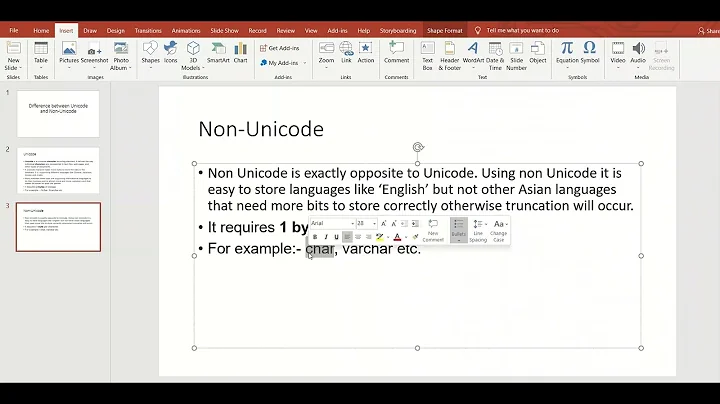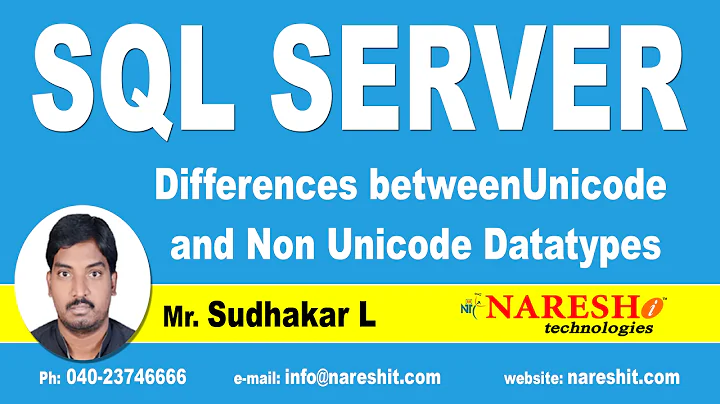Unicode to Non-Unicode conversion
Solution 1
There are a few things to note here:
-
If you want to see exactly which character is there, you can convert the value to
VARBINARYwhich will give you the hex / binary value of all characters in the string and there is no concept of "hidden" characters in hex:DECLARE @PostalCode NVARCHAR(20); SET @PostalCode = N'053000'+ NCHAR(0x2008); -- 0x2008 = "Punctuation Space" SELECT @PostalCode AS [NVarCharValue], CONVERT(VARCHAR(20), @PostalCode) AS [VarCharValue], CONVERT(VARCHAR(20), RTRIM(@PostalCode)) AS [RTrimmedVarCharValue], CONVERT(VARBINARY(20), @PostalCode) AS [VarBinaryValue];Returns:
NVarCharValue VarCharValue RTrimmedVarCharValue VarBinaryValue 053000 053000? 053000? 0x3000350033003000300030000820NVARCHARdata is stored as UTF-16 which works in 2-byte sets. Looking at the last 4 hex digits to see what the hidden 2-byte set is, we see "0820". Since Windows and SQL Server are UTF-16 Little Endian (i.e. UTF-16LE), the bytes are in reverse order. Flipping the final 2 bytes --08and20-- we get "2008", which is the "Punctuation Space" that we added viaNCHAR(0x2008).Also, please note that
RTRIMdid not help at all here. -
Simplistically, you can just replace the question marks with nothing:
SELECT REPLACE(CONVERT(VARCHAR(20), [PostalCode]), '?', ''); -
More importantly, you should convert the
[PostalCode]field toVARCHARso that it doesn't store these characters. No country uses letters that are not represented in the ASCII character set and that are not valid for the VARCHAR datatype, at least as far as I have ever read about (see bottom section for references). In fact, what is allowed is a rather small subset of ASCII, which means you can easily filter on the way in (or just do the sameREPLACEas shown above when inserting or updating):ALTER TABLE [table] ALTER COLUMN [PostalCode] VARCHAR(20) [NOT]? NULL;Be sure to check the current
NULL/NOT NULLsetting for the column and make it the same in the ALTER statement above, else it could be changed as the default isNULLif not specified. -
If you cannot change the schema of the table and need to do a periodic "cleansing" of the bad data, you can run the following:
;WITH cte AS ( SELECT * FROM TableName WHERE [PostalCode] <> CONVERT(NVARCHAR(50), CONVERT(VARCHAR(50), [PostalCode])) ) UPDATE cte SET cte.[PostalCode] = REPLACE(CONVERT(VARCHAR(50), [PostalCode]), '?', '');Please keep in mind that the above query is not meant to work efficiently if the table has millions of rows. At that point it would need to be handled in smaller sets via a loop.
For reference, here is the wikipedia article for Postal code, which currently states that the only characters ever used are:
- The arabic numerals "0" to "9"
- Letters of the ISO basic Latin alphabet
- Spaces, hyphens
And regarding the max size of the field, here is the Wikipedia List of postal codes
Solution 2
As long as "?" is not allowed in a real PostalCode value, you can cast first, and then remove these characters using REPLACE to replace them with the empty string:
replace(cast((PostalCode) as varchar))), '?', '')
Warning
These '?' characters represent Unicode characters in the original nvarchar value that were not converted to an equivalent ASCII varchar character. This means that this method will silently remove any such characters. You said you wanted to simply remove these characters, but you might want to rethink that.
To give an example, if the postal code can contain letters, and someone accidentally typed a letter with an accent:
1234-ÁBCD
The end result would be:
1234-BCD
Related videos on Youtube
Rameshwar Pawale
Updated on June 04, 2022Comments
-
Rameshwar Pawale almost 2 years
I have some Unicode characters in an
NVarcharfield named "PostalCode". When I convert them toVarchar, there is a?in the result.My code is:
select PostalCode, cast((PostalCode) as varchar)) as val from tableand the result is:
PostalCode | val 053000 | 053000?Here I am getting a
?in the result. Is there any way to remove such special characters?-
 Panagiotis Kanavos over 9 yearsWhy are you trying to convert Unicode? It's better to use Unicode throughout an application. Anyway
Panagiotis Kanavos over 9 yearsWhy are you trying to convert Unicode? It's better to use Unicode throughout an application. Anyway?means there are characters in the input string that can't be represented in the target codepage. Does your input contain invisible characters after the last number? I suspectLEN(PostalCode)will return 7 or higher. -
 Dan Getz over 9 yearsYou can probably expect all postal codes to be expressible in [0-9][A-Z]. The one thing you might worry about is if the postal code can contain letters, and someone accidentally typed a letter with an accent. For example, if you process these by dropping non-ASCII characters, "1234-ÁBCD" would not indicate an error, and simply become "1234-BCD" instead of "1234-ABCD".
Dan Getz over 9 yearsYou can probably expect all postal codes to be expressible in [0-9][A-Z]. The one thing you might worry about is if the postal code can contain letters, and someone accidentally typed a letter with an accent. For example, if you process these by dropping non-ASCII characters, "1234-ÁBCD" would not indicate an error, and simply become "1234-BCD" instead of "1234-ABCD".
-
-
 user over 9 yearsExcept the original value doesn't appear to show anything that the conversion output doesn't include. It looks like the conversion is just adding a question mark (whatever that question mark might represent).
user over 9 yearsExcept the original value doesn't appear to show anything that the conversion output doesn't include. It looks like the conversion is just adding a question mark (whatever that question mark might represent). -
 Panagiotis Kanavos over 9 yearsThe original value probably contains garbage non-visible characters after the last 0, otherwise it could be converted to any codepage. Numbers and the space character are available in all codepages
Panagiotis Kanavos over 9 yearsThe original value probably contains garbage non-visible characters after the last 0, otherwise it could be converted to any codepage. Numbers and the space character are available in all codepages -
 rory.ap over 9 years@MichaelKjörling Maybe there's a unicode character in the table that wasn't carried over in the copy/paste to this post.
rory.ap over 9 years@MichaelKjörling Maybe there's a unicode character in the table that wasn't carried over in the copy/paste to this post. -
 Panagiotis Kanavos over 9 years@MichaelKjörling Unicode contain single characters like
Panagiotis Kanavos over 9 years@MichaelKjörling Unicode contain single characters like...or,(yes, with the space). There are also at least 16 different spaces, joiners etc (U+2000 to U+200F) -
Rameshwar Pawale over 9 years@roryap - there is a space after 0 in original unicode value.
-
 rory.ap over 9 years@RameshwarPawale -- Are you sure it was U+0020 (regular space) and not U+00A0 (non-breaking space) or U+2002 ("en-space") or U+2003 ("em-space") or one of the others? That's what I'm getting at. BTW, it seems like it's not possible to copy and paste those actual spaces into SO -- they get converted into U+0020, which is why in your post it looks like a normal space.
rory.ap over 9 years@RameshwarPawale -- Are you sure it was U+0020 (regular space) and not U+00A0 (non-breaking space) or U+2002 ("en-space") or U+2003 ("em-space") or one of the others? That's what I'm getting at. BTW, it seems like it's not possible to copy and paste those actual spaces into SO -- they get converted into U+0020, which is why in your post it looks like a normal space. -
 rory.ap over 9 yearsThis assumes that the OP has control over the DB schema.
rory.ap over 9 yearsThis assumes that the OP has control over the DB schema. -
 Solomon Rutzky over 9 years@roryap . Understood. However, it is just a recommendation. I did provide a way to accomplish the question, though I can make an update to account for having no control over the schema.
Solomon Rutzky over 9 years@roryap . Understood. However, it is just a recommendation. I did provide a way to accomplish the question, though I can make an update to account for having no control over the schema. -
 Jonathan Leffler over 9 yearsWhen you say "No country allows for Unicode characters in their postal codes", you are making a sweeping statement that isn't 100% accurate, since the Latin alphabet and Arabic digits are perfectly valid Unicode characters. You mean something more like "No country allows for Unicode characters outside the range U+0020 .. U+007E (equivalent to ASCII or the printing characters in the lower half of ISO 8859-1) in their postal codes". I'm not sure how to express that compactly; maybe "No country allows for Unicode characters that are not also ASCII printing characters in the postal codes".
Jonathan Leffler over 9 yearsWhen you say "No country allows for Unicode characters in their postal codes", you are making a sweeping statement that isn't 100% accurate, since the Latin alphabet and Arabic digits are perfectly valid Unicode characters. You mean something more like "No country allows for Unicode characters outside the range U+0020 .. U+007E (equivalent to ASCII or the printing characters in the lower half of ISO 8859-1) in their postal codes". I'm not sure how to express that compactly; maybe "No country allows for Unicode characters that are not also ASCII printing characters in the postal codes". -
 Solomon Rutzky over 9 years@JonathanLeffler Thanks for commenting. That is why I copied the text of the Wikipedia article stating "ISO basic Latin alphabet". So maybe "no country uses letters that are not represented in the ASCII character set and that are not valid for the VARCHAR datatype"? Shouldn't need to mention printability as the only other characters are 0 - 9, space, and hyphen.
Solomon Rutzky over 9 years@JonathanLeffler Thanks for commenting. That is why I copied the text of the Wikipedia article stating "ISO basic Latin alphabet". So maybe "no country uses letters that are not represented in the ASCII character set and that are not valid for the VARCHAR datatype"? Shouldn't need to mention printability as the only other characters are 0 - 9, space, and hyphen. -
 Solomon Rutzky over 9 yearsWhat if it is multiple characters? And/or what if they are different Unicode characters?
Solomon Rutzky over 9 yearsWhat if it is multiple characters? And/or what if they are different Unicode characters? -
 Dan Getz over 9 yearsThen my second method is not the right thing to do. (But it might still be worth trying
Dan Getz over 9 yearsThen my second method is not the right thing to do. (But it might still be worth tryingRTRIMto see if it works.) This is an answer to one interpretation of the original question, "how do I get rid of only this particular character on the end". -
 Jonathan Leffler over 9 yearsYes, I know it's at the bottom, but maybe a '(see below)' or something similar. As it stands, your statement in item 2 is a contradiction; the postal code characters are Unicode characters; they are just particularly common/simple ones.
Jonathan Leffler over 9 yearsYes, I know it's at the bottom, but maybe a '(see below)' or something similar. As it stands, your statement in item 2 is a contradiction; the postal code characters are Unicode characters; they are just particularly common/simple ones. -
 Solomon Rutzky over 9 years@JonathanLeffler Understood. And I agree that statements should be as clear as possible, so I have updated #2 to do both things: a) updated the text, and b) referenced the bottom section. Thanks again.
Solomon Rutzky over 9 years@JonathanLeffler Understood. And I agree that statements should be as clear as possible, so I have updated #2 to do both things: a) updated the text, and b) referenced the bottom section. Thanks again.




